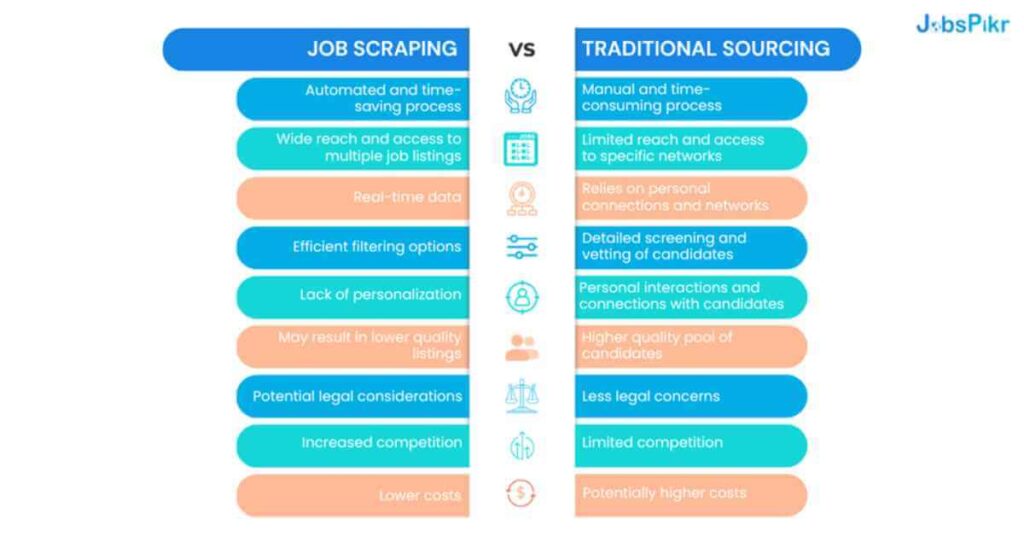Job Scraping vs. Traditional Sourcing: Pros and Cons for Recruitment Professionals

Recruitment professionals play a crucial role in identifying and attracting top talent. They’re always on the lookout for fresh and effective approaches to locate the finest talent for their organizations. However, the conventional ways of sourcing candidates can be time-consuming and may not always yield the desired results.
Job scraping and traditional sourcing offer different ways to tackle these challenges, and understanding their differences can help recruitment professionals choose the right approach for their hiring needs. Both approaches have their own advantages and limitations, making it essential for recruitment professionals to understand their pros and cons.
In this article, we will explore the definitions, processes, pros, and cons of job scraping and traditional sourcing. This comparison will equip you with the information needed to make a well-informed decision.
Job Scraping
Job scraping refers to the automated process of extracting job listings from various websites and aggregating them into a centralized database. This method employs software and algorithms to gather important job details like job titles, descriptions, and locations. This streamlined approach is efficient, as it eliminates the need for recruiters to manually search numerous job boards and company sites for available job opportunities.
The process of job scraping typically involves four steps:
- Identifying Target Websites: Recruitment professionals need to identify the platforms that contain the job listings they are interested in, including job boards, corporate websites, and online forums.
- Scraping and Extracting Data: Specialized software or web scraping tools are used to extract the relevant data from the identified websites. This can include job titles, descriptions, requirements, and contact details.
- Cleaning and Organizing Data: Once the data is extracted, it’s important to meticulously clean and arrange it to guarantee precision and uniformity. This may involve removing duplicates, standardizing job titles, and categorizing the information.
- Updating and Monitoring: The task of collecting job information is an ongoing effort since fresh job postings are consistently being posted while older ones get occupied. The extracted data needs to be updated and monitored regularly to ensure it remains up-to-date and relevant.
Pros of Job Scraping:
- Time and Effort Saving: Job scraping automates the process of searching for job listings, saving recruiters significant time and effort.
- Wider Reach: Job scraping allows access to a large pool of job opportunities from multiple websites, increasing the chances of finding suitable candidates.
- Real-time Data: Job scraping pulls data in real-time, ensuring recruiters have the most up-to-date information about job openings.
- Efficient Filtering: Job scraping tools can filter job listings based on specific criteria, such as location, industry, or keywords, making it easier to find relevant positions.
Cons of Job Scraping:
- Quality Control: Job scraping may result in a large quantity of job listings, but the quality of the listings may vary. Some scraped listings may be outdated or inaccurate.
- Limited Personalization: Job scraping relies on algorithms and automation, which may lack the personal touch when reaching out to potential candidates.
- Legal Considerations: Job scraping must be done while adhering to the terms and conditions of the websites being scraped. Violating these terms may result in legal repercussions.
- Competition: Job scraping is a popular method, meaning the same job listings are often scraped by multiple recruiters, increasing competition for candidates.
Traditional Sourcing
Traditional sourcing refers to the conventional methods of finding and attracting candidates, such as posting job advertisements, utilizing personal and professional networks, and partnering with recruitment agencies. These methods involve a more manual and hands-on approach, relying on human interaction and personal connections.
Some common methods of traditional sourcing include:
- Job Advertisements: Posting job ads on various platforms such as newspapers, job boards, and social media to attract candidates.
- Referrals: Utilizing personal and professional networks to get referrals from employees, colleagues, and industry contacts.
- Recruitment Agencies: Partnering with recruitment agencies to leverage their expertise and networks to source suitable candidates.
- Direct Contact: Approaching potential candidates directly through LinkedIn, networking events, or industry conferences.
Pros of Traditional Sourcing:
- Personal Connection: Traditional sourcing methods allow for direct human interaction, enabling recruiters to build personal connections with potential candidates.
- Targeted Approach: By leveraging personal and professional networks, recruiters can target specific candidates who may be a good fit for the organization.
- Detailed Screening: Traditional sourcing methods often involve more thorough screening and vetting of candidates, ensuring a higher quality pool of candidates.
- Ability to Gauge Cultural Fit: Personal interactions in traditional sourcing methods provide an opportunity to gauge a candidate’s cultural fit within the organization.
Cons of Traditional Sourcing:
- Time-consuming: Traditional sourcing methods can be time-consuming, as they involve manual searching, screening, and follow-up with candidates.
- Limited Reach: Traditional sourcing methods may not reach a wide pool of candidates, especially those who are not actively looking for job opportunities.
- Reliance on Personal Networks: Traditional sourcing heavily relies on personal and professional networks, limiting access to candidates outside of those networks.
- Higher Costs: Traditional sourcing methods may involve costs such as advertising fees and recruitment agency fees, increasing the overall hiring budget.
Comparison of Job Scraping vs. Traditional Sourcing

Understanding the pros and cons of different sourcing methods is crucial for recruitment professionals. Job scraping offers the benefits of automation, wider reach, and real-time data, while traditional sourcing focuses on personal connections, targeted approaches, and detailed screening.
Considering the specific requirements of their organizations and the nature of the positions they are hiring for, recruitment professionals can make informed decisions on whether to use job scraping, traditional sourcing, or a combination of both, to find the best talent for their organizations.
Contact JobsPikr today, the experts in job scraping, to explore how their cutting-edge solutions can transform your recruitment process. Unlock a world of possibilities, save time, and stay ahead of the competition with JobsPikr. Your next top hire could be just a click away!
